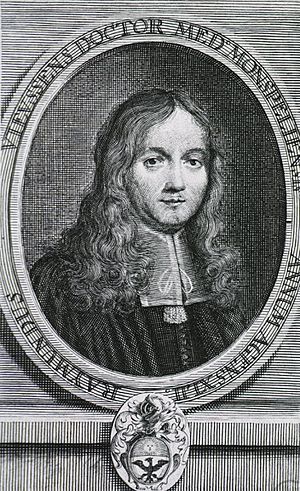Raymond Vieussens facts for kids
Raymond Vieussens (born around 1635 – died August 16, 1715) was a French doctor and expert in human anatomy. He was born in a town called Le Vigan. There's a bit of mystery about his exact birth year, with some records suggesting it might have been as late as 1641.
He studied medicine at the University of Montpellier and earned his degree in 1670. Later, he became the head doctor at a hospital in Montpellier called Hôtel Dieu Saint-Eloi.
Contents
Discovering the Heart and Brain
Raymond Vieussens is famous for his important work on the heart (cardiology) and his detailed studies of the brain and spinal cord. He looked up to an English anatomist named Thomas Willis as a big inspiration for his career.
Understanding the Heart's Secrets
Vieussens was one of the first doctors to accurately describe parts of the left ventricle of the heart and many of its blood vessels. He also gave a full description of mitral stenosis, which is a condition where a heart valve narrows. He described other types of heart disease and problems with the circulatory system, which is how blood moves through your body.
Exploring the Brain
He also gave an early description of a part of the brain called the centrum semiovale. Sometimes, this area is still called "Vieussens' centrum" in his honor. Another doctor, Félix Vicq-d'Azyr, later provided an even more detailed description of it.
Parts of the Body Named After Him
Several other body parts were once named after Vieussens, but their names have mostly changed over time. These include:
- "Vieussens' valve" (now called the superior medullary velum)
- "Vieussens' ventricle" (a space in the septum pellucidum of the brain)
- "Vieussens' ansa" (now known as the subclavian loop)
- "Vieussens' ganglia" (now called the celiac ganglia)
- "Vieussens' isthmus" (now the limbus of fossa ovalis)
- "Vieussens' veins" (now called the innominate cardiac veins)
He also described tiny openings in the veins of the right atrium of the heart. These are known as "Vieussens' foramina" or foramina venarum minimarum. Sometimes, they are called "Thebesian foramina" after another doctor, Adam Christian Thebesius.
Another important discovery in heart studies named after him is the Vieussens collateral. This is a special connection between two important heart arteries: the right coronary artery (RCA) and the left anterior descending artery (LAD). This connection helps provide blood flow to the heart muscle if one of the main arteries is blocked. It can reduce damage to the heart.
His Important Books
Among his written works, two stand out:
- Neurographia universalis: This was an early book about the neuroanatomy (the study of the nervous system). It was known for its amazing illustrations made from copper plates.
- Novum vasorum corporis humani systema: This was a very important book about the anatomy and diseases of the heart.
During his life, Vieussens was also known for some of his ideas about how the human body works. These ideas sometimes went beyond what could be proven with the science available at the time.
Selected Works
Here are some of the important books and papers Raymond Vieussens wrote:
- Neurographia universalis (General Neurography) (1684)
- Vieussens's Tractatus duo (Treatise on Two Subjects) (1688)
- Epistola de sanguinis humani (An Article on Human Blood) (1698)
- Novum vasorum corporis humani systema (Vessels of the Human Body), a classic work on cardiology (1705)
- The Structure of the Human Heart (1706)
- Dissertatio anatomica de structura et usu uteri ac placentae muliebris (Anatomical Study on the Structure of the Uterus and Placenta) (1712)
- Traité nouveau de la structure de l'oreille (Treatise on the Structure of the Ear) (1714)
- Traité nouveau des liqueurs du corps humain (Treatise on the Fluids of the Human Body) (1715)
- Traité nouveau de la structure et des causes du mouvement naturel du coeur (Treatise on the Structure of the Heart and the Causes of its Natural Motion) (1715)
See also
 In Spanish: Raymond Vieussens para niños
In Spanish: Raymond Vieussens para niños


